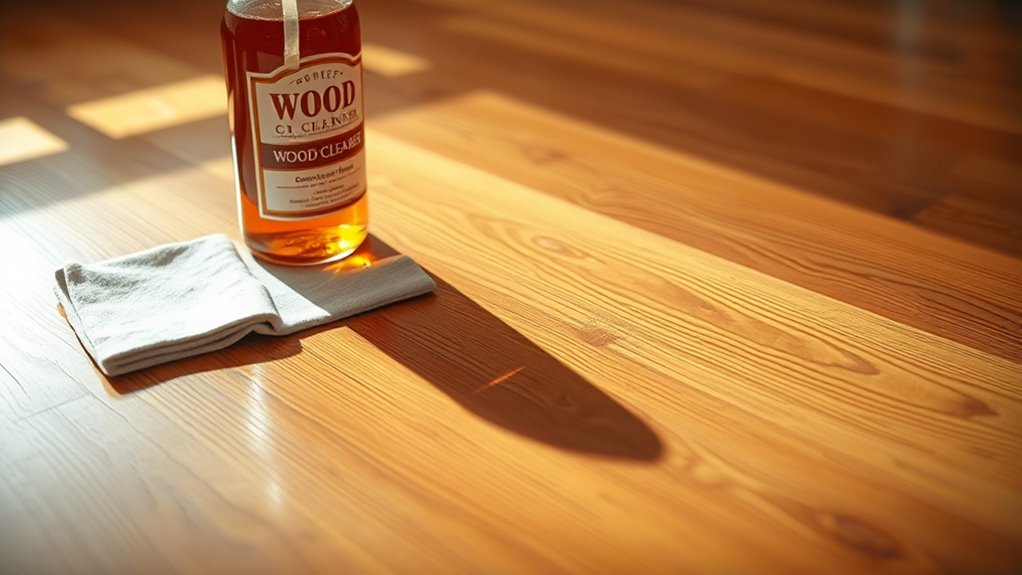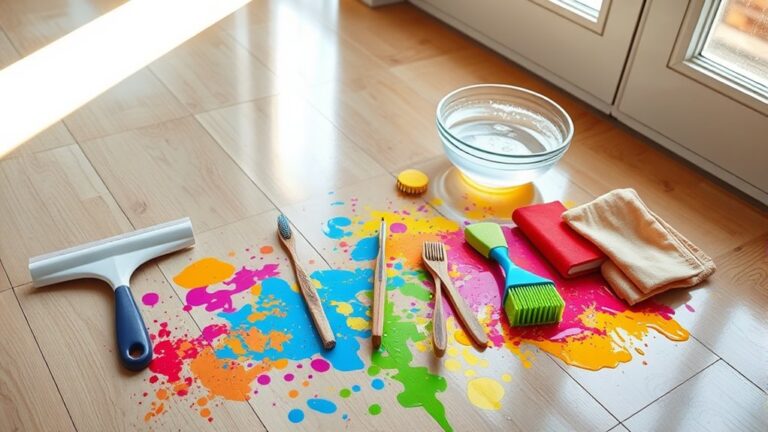To remove scuff marks from wood floors, first identify your floor’s finish to avoid damage. Use a soft microfiber cloth with warm water for light marks. For tougher spots, apply a baking soda paste or gently use a damp Magic Eraser, testing it on a hidden area first. Toothpaste and diluted white vinegar solutions also work as mild abrasives. Finish by buffing to restore shine and consider preventive measures to protect your floors. More detailed techniques can help you maintain pristine wood surfaces.
Identify the Type of Wood Floor Finish
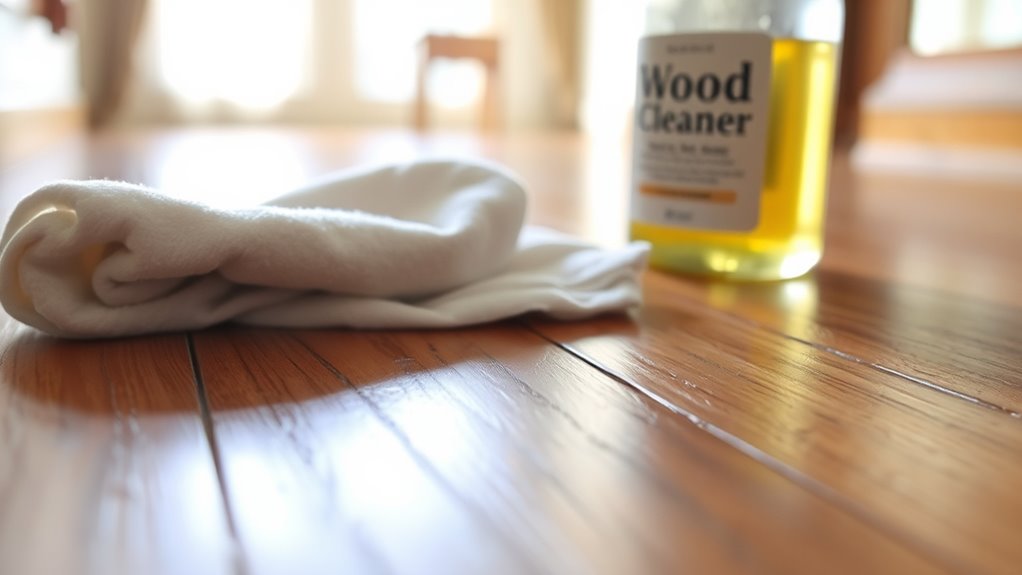
Before you begin removing scuff marks, it’s essential to identify the type of finish on your wood vloer. Different wood floor types, such as oak, maple, or pine, often feature finishes ranging from polyurethane to wax or oil-based coatings. Each finish offers varying levels of finish durability, impacting your approach to scuff removal. For example, polyurethane finishes provide a hard, protective layer, allowing for more aggressive cleaning methods without damage. In contrast, wax or oil finishes are softer and more susceptible to wear, requiring gentler techniques. By accurately determining your floor’s finish, you can select the most effective and safe cleaning strategy, preserving the wood’s integrity and maintaining the freedom to enjoy a pristine surface without unintended harm.
Gather Essential Cleaning Supplies
To effectively remove scuff marks from your wood floors, you’ll need to gather a specific set of cleaning supplies tailored to the floor finish you’ve identified. Choosing the right cleaning tools is vital to avoid damage and guarantee efficient removal. Focus on essential supplies that provide both precision and gentle action.
Here are three key items to have on hand:
- Microfiber cloths – Soft and non-abrasive, perfect for delicate wood surfaces.
- Mild cleaning solution – pH-neutral and compatible with your floor’s finish to prevent deterioration.
- Eraser sponge – Effective for stubborn marks but should be used cautiously to avoid surface abrasion.
Collecting these essential supplies guarantees you’re equipped to restore your wood floors without compromising their integrity.
Use a Soft Cloth and Warm Water
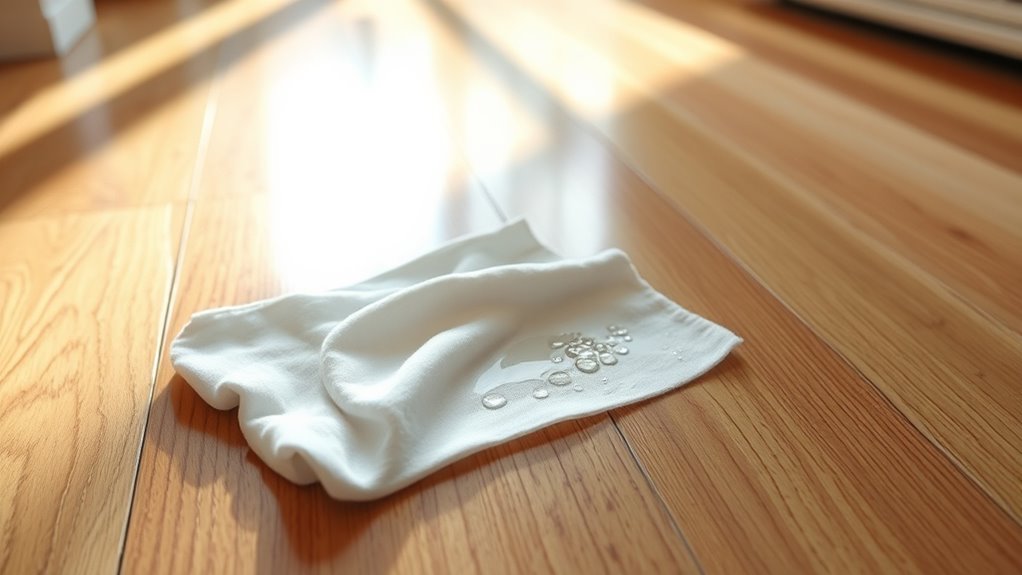
You’ll want to select a soft, non-abrasive cloth to avoid damaging the wood’s finish. Prepare a warm water solution, ensuring it’s not too hot to prevent warping or discoloration. Use gentle, controlled motions when cleaning to effectively remove scuff marks without harming the floor.
Choosing the Right Cloth
Although many cleaning tools are available, selecting a soft cloth is crucial for effectively removing scuff marks without damaging your wood floors. You want a cloth that’s gentle yet efficient in lifting marks without scratching the finish. Consider these options:
- Microfiber cloths: Their fine synthetic fibers trap dirt and scuffs while being non-abrasive and highly absorbent.
- Cotton rags: Soft natural fibers that provide gentle friction, ideal for delicate wood surfaces.
- Avoid rough or coarse materials: These can scratch or dull your floor’s finish, negating your cleaning efforts.
Choose a cloth that allows you to apply just enough pressure to remove marks without risking damage. Combining the right cloth with warm water guarantees a safe and effective cleaning experience that preserves your wood’s natural beauty and your freedom to maintain it yourself.
Preparing Warm Water Solution
Selecting a soft cloth sets the foundation for preparing an effective warm water solution. You’ll want to fill a container with water at a temperature that balances cleaning efficacy and wood safety—typically between 90°F and 110°F. This range maximizes warm water benefits by loosening dirt and scuff residues without risking wood damage or finish deterioration. Avoid hot water, which can warp or discolor floors, and cold water, which reduces cleaning power. Once your water is at the ideal temperature, immerse the soft cloth briefly, then wring it out thoroughly to prevent excess moisture on wood surfaces. This controlled moisture level guarantees your cleaning process respects the integrity of the wood, while effectively preparing the solution to tackle scuff marks with precision and care.
Gentle Cleaning Techniques
When tackling scuff marks on wood floors, using a soft cloth dampened with your prepared warm water solution guarantees effective cleaning without risking damage. This method employs gentle scrubbers, preventing scratches while loosening debris. To maximize results, follow these steps:
- Lightly wring the cloth to avoid excess moisture, which can warp wood.
- Gently rub the scuff marks in a circular motion, allowing natural remedies in the solution to break down residues.
- Dry the area immediately with a clean, dry cloth to prevent water absorption.
Apply Baking Soda for Stubborn Marks
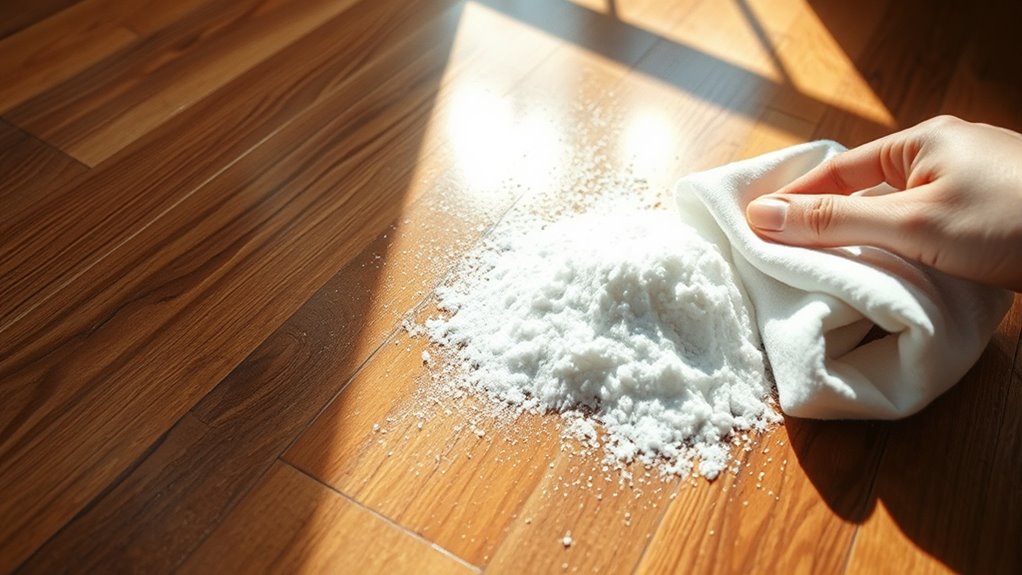
If warm water and a cloth don’t remove the scuff, you can create a baking soda paste by mixing it with a small amount of water until it forms a thick consistency. Apply the paste gently to the stubborn marks using a soft cloth or sponge, avoiding excessive pressure to prevent damage. After scrubbing, wipe the area clean with a damp cloth and dry thoroughly to remove any residue.
Baking Soda Paste Preparation
A baking soda paste offers a gentle yet effective solution for removing stubborn scuff marks from wood floors. To prepare this paste, you’ll need to precisely combine baking soda with water for ideal consistency and efficacy.
- Measure 2 tablespoons of baking soda—this amount balances abrasiveness to avoid floor damage.
- Gradually add 1 tablespoon of water, mixing continuously to form a thick, spreadable paste.
- Adjust the water quantity slightly if needed; the paste should be firm enough to stay in place without dripping.
This preparation guarantees the baking soda’s mild abrasive properties target scuff marks effectively while preserving your wood floor’s finish. Mastering this step grants you control and freedom in maintaining your floors without harsh chemicals.
Toepassingstechnieken
Although baking soda paste is gentle, applying it correctly is crucial for effectively removing stubborn scuff marks without damaging your wood floor. Start by dampening a soft cloth or sponge, then dip it into the paste. Use gentle, circular motions to work the baking soda into the scuff, avoiding excessive pressure that could harm the finish. Application methods involving direct scrubbing with abrasive tools should be avoided. Allow the paste to sit briefly to break down marks but don’t let it dry completely. This technique not only removes scuffs but also supports scuff prevention by maintaining the floor’s protective layer. Consistent, careful application guarantees you preserve your floor’s integrity while restoring its appearance, giving you the freedom to enjoy your space without worry.
Cleaning and Rinsing Tips
Once you’ve gently applied the baking soda paste to stubborn scuff marks, it’s important to clean and rinse the area properly to prevent residue buildup that can dull the floor’s finish. Effective cleaning techniques and rinsing methods guarantee your wood floors remain vibrant and protected. Follow these steps:
- Use a damp microfiber cloth to wipe away the baking soda paste, applying gentle pressure to avoid scratching the wood.
- Rinse the cloth frequently in clean, lukewarm water to remove all residue thoroughly.
- After removing the paste, dry the area immediately with a soft, dry cloth to prevent moisture damage.
Try a Magic Eraser for Tough Scuffs
If tougher scuff marks won’t budge with traditional cleaning methods, you should try using a Magic Eraser. This product leverages melamine foam’s micro-abrasive properties to effectively lift embedded dirt and scuffs without harsh chemicals. To maximize magic eraser effectiveness, dampen it slightly and test on an inconspicuous area first to avoid surface damage. Apply gentle pressure while wiping the scuff mark, using small, controlled motions. Remember, frequent use can wear down finishes, so limit application to stubborn spots only. Alongside this, incorporating scuff prevention tips such as placing felt pads under furniture and using area rugs can reduce future damage. With careful use, a Magic Eraser offers a precise, efficient solution that frees your wood floors from persistent scuff marks without compromising their integrity.
Use Toothpaste as a Gentle Abrasive
When you need a mild abrasive to tackle scuff marks without risking damage to your wood floors, toothpaste can be an effective choice. Select a toothpaste type with non-gel, white paste formula, as it contains mild abrasive properties ideal for cleaning without scratching. To apply:
- Dab a small amount of toothpaste on a soft cloth or cotton ball.
- Gently rub the scuff mark in a circular motion, applying light pressure.
- Wipe off residue with a damp cloth and dry thoroughly.
Avoid colored or gel toothpastes, which may stain or lack sufficient abrasiveness. This method leverages toothpaste’s controlled abrasive action to lift marks while preserving your floor’s finish, giving you a reliable, accessible solution for light scuff removal.
Remove Scuffs With White Vinegar Solution
To complement the gentle abrasion method with toothpaste, you can use a white vinegar solution to effectively break down and lift scuff marks on wood floors. Vinegar effectiveness lies in its mild acidity, which dissolves residue without damaging the finish. Mix one part white vinegar with two parts water, apply sparingly with a soft cloth, and gently rub the scuff. This method supports scuff prevention by maintaining the floor’s protective layer.
| Stap | Detail |
|---|---|
| Solution Ratio | 1 part vinegar : 2 parts water |
| Application Tool | Soft cloth or microfiber |
| Techniek | Gentle rubbing |
| Frequentie | As needed for scuff marks |
| Precaution | Avoid excess moisture |
Use this precise approach to preserve your freedom to enjoy flawless wood floors.
Buff the Floor to Restore Shine
Buffing the floor revives its natural luster by smoothing out minor imperfections and evenly distributing the finish. To achieve effective floor polishing and shine restoration, follow these steps:
- Use a clean, soft cloth or a microfiber pad attached to a floor buffer designed for wood floors.
- Apply a thin layer of a suitable floor polish or wax, ensuring even coverage without excess buildup.
- Buff the floor using slow, circular motions, applying light pressure to enhance gloss without damaging the surface.
This process not only eliminates residual scuff marks but also restores the floor’s protective layer, allowing you to maintain freedom from dullness and wear. Proper buffing extends the life of your wood floor’s finish and keeps it looking vibrant and polished.
Prevent Future Scuff Marks on Wood Floors
Maintaining the restored shine of your wood floors involves more than just regular buffing—it requires proactive measures to prevent new scuff marks from forming. Implement preventive measures such as placing floor protectors under furniture legs to reduce friction and minimize scratches. Use high-quality felt pads or rubber caps, replacing them periodically to guarantee effectiveness. Additionally, consider area rugs in high-traffic zones to act as barriers against dirt and abrasive particles. Encourage the removal of shoes indoors to limit dirt and grit accumulation that contribute to scuffing. Regularly clean floors with a microfiber mop to remove fine debris without scratching the surface. By integrating these preventive measures, you maintain both the aesthetic and structural integrity of your wood floors, allowing you the freedom to enjoy their beauty without constant worry about damage.

